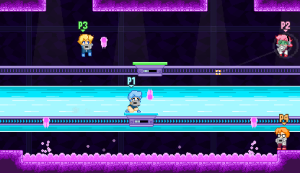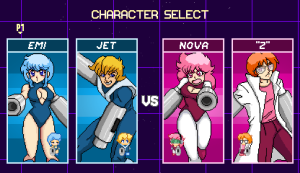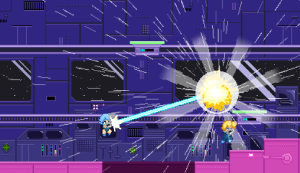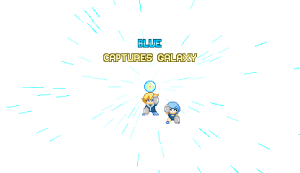Capsule Force is a couch-competitive battle arena where players compete for control of galaxies in a 1980’s anime-inspired vision of the future using laser beams, infinite jumps, reflecting shields and a combination of wit and reflexes. If it sounds unique and eccentric, that is kind of the point.
Instead of a traditional life gauge system, combatants need to advance from one screen to the next in order to approach the goal and claim victory. Movement is controlled by two trams available to both teams (1 v 1 or 2 v 2) and deciding when to push forward and defend offers a unique risk, reward system not seen in many other fighting games.
I was fortunate enough learn more about Capsule Force from developer Eric Wenske and share his insight on game design, trophy integration and the inspiration for his latest game.
 Q: What is your design philosophy for creating games?
Q: What is your design philosophy for creating games?
It all depends on what experience I want to deliver the player. I gravitate toward arcade-style experiences, and put a lot of focus on analog movements that can be improved through skill. It can come from a simple control systems with a complex variety of outcomes. Pressing jump and having a character always jump the same amount is a lot less interesting to me than a character whose jump height is dependent on the length of time the jump button was held.
I also enjoy character animations reacting to game systems and not the other way around. Real world human motions require muscles to do things, and games don’t need to emulate that. Skipping many of these wind-ups can make a game feel much more responsive, and in a world of LCD TVs (many of which aren’t set to Game Mode!), we need all the frames we can get!
Speaking of these things, I think one reason Mario 64 is such a popular speedrun game to watch is due to its embracing of the above two points. Players can skip entire portions of levels though mastery of Mario’s simple but powerful move set.
Q: How does Capsule Force differ from other games that you’ve worked on?
I have worked at multiple studios in the past, and one thing about older games that I really missed while working was the ability to quickly jump into a game and enjoy it without having to sit through story and tutorials. I am huge fan of old Sega games and the arcade qualities even their console games have. I try to capture a lot of this with Capsule Force. I want the players to be able to get in quickly, enjoy the game, and to be entertained with both fun gameplay and fun visuals the whole way through!
Q: Capsule Force has a unique win condition for combat. How did you come up with the idea of rails and capturing the galaxy?
We were looking for interesting multiplayer ideas, and TF2’s push-the-cart mode was an inspiration here. I have always been a fan of getting from one place to another using tracks. It also fit the 80s anime sci-fi theme of the game.
We tried it out with one track and one tram, but it quickly became clear that players are going to constantly be playing close range as they try to get to the tram, and I wanted there to be a greater focus on the skill of accurately aiming at the other players. We went through multiple ideas on how to keep players away from each other, but a second tram came about as both a simple and elegant solution to the problem that didn’t complicate the rule set.
Now how did we come up with the idea of capturing galaxies as a win condition? Good question! I think the gameplay, setting, and game name all came together before the story did. The name “Capsule Force” fit the atmosphere of the game, so we made the goal objects capsules. Similar to how we wanted all of the characters to feel very fast and powerful (in that anime kind of way), we wanted the capsules to have a ridiculous power as well. They will capture and hold entire galaxies! It also hit on another aspect of many arcade games that I enjoy, stories that you could completely ignore and still have no trouble getting through the game. You could definitely enjoy Capsule Force without ever understanding the capturing of galaxies or the galactic wars on 1999!
 Q: How long does the average match take?
Q: How long does the average match take?
A typical round lasts around 2 minutes. Some levels run longer than others. A 3 minutes level timer is enabled by default and is adjustable in the options. Running out of time puts players into Sudden Death Mode!
Q: Do all the characters have access to the same abilities?
Yes. We wanted to focus on getting the moveset of the players feeling right, and not overcomplicating it by having to balance multiple weapons against each other.
Q: How do the single player missions work? Are they good training for the frantic multiplayer combat?
The single player missions are split up into four categories that focus on accurately aiming your weapon, dodging hazards, and quickly traversing through levels. Mastering the missions will absolutely help hone player skills for the multiplayer combat. In fact, I think players will find that the better they become, the less frantic the combat becomes. Players tend to start realizing accuracy over rapid shots gives them a strong upper hand.
Q: The inspiration from anime comes across in the game’s design. Were there any that you drew upon for inspiration specifically?
We looked at the worlds and effects of Dirty Pair. I would go frame-by frame looking at speed lines, crescent moon explosion effects, and wall textures for inspiration. In addition, Macross and Galaxy Express 999 were good sources of inspiration for frontier environments. Really though, it was combing through a lot of different retro anime titles and finding common themes we liked. I would actually throw shows into VLC and generate screen grabs every few seconds and then had a tool that would load them into nice image grids in web pages that made finding quick references easy!
Q: What was the inspiration for the soundtrack of the game? Will it be available separately?
Kat did all of the music and sfx for this game, so I will defer to her:
The soundtrack for Capsule Force touches on evoking a sense of nostalgia with slight hints of modern elements. For inspiration, I listened to old 80s anime music and early 90s arcade games and tried to keep in mind the types of flavors they liked to toss around. My goal was to capture the essence of the golden 80s-early 90s, but not creatively be limited to a 16-bit era restrictions, so there’s a fair bit of older synths mixed with tidbits of more modern VSTs. I haven’t really thought about having the OST available, but that’d be rad!
 Q: I’m a huge trophy fan…how did you determine what trophies to include within Capsule Force?
Q: I’m a huge trophy fan…how did you determine what trophies to include within Capsule Force?
Ha! I have more complicated opinions on trophies and achievements. Sometimes, just finding something interesting in a game is fun by itself without the need to be told that it is interesting through a trophy popup, but that isn’t necessarily the fault of the trophy system.
I like when trophies are tied to skill-based achievements which is how most of the Capsule Force trophies work. But not only will you unlock a trophy, you will also be unlocking new stage layouts, outfits, and concept art!
Q: What was the first game (published or unpublished) that you created?
I have been making games in some form since I was a kid. Early on, I would draw Sonic levels onto notebook paper. They were probably pretty awful level designs! One of the first full video games I remember making was a project named Fatal Inflation. It was a single screen game where you played a character with a balloon for a head. You could move left and right, but could also inflate or deflate your head. Arrows would fly in from the left and right sides of the screen. Touching the arrows and any edge of the screen would kill you!
Q: What advice do you have for developers trying to break into the industry?
This is always a difficult question, because I have heard so many different stories of how people got into the industry. There is no one right way. I used to think there were multiple ways that would never work, but I met people who made it in those ways too!
One piece of advice that I would give is to work on projects! When I got my first industry job, I had multiple mods and personal game projects / prototypes that I had worked on that I could show. I put a lot of work into learning about game development by developing games (before it was my job!), and now that is easier than ever with so many free tools out there that are much better that what I had to work with!
 Q: As Klobit is about to publish its first game, is there anything you wish you knew at the beginning of the project that you have learned?
Q: As Klobit is about to publish its first game, is there anything you wish you knew at the beginning of the project that you have learned?
Iron Galaxy will be publishing this game and they have been awesome!
Early on, I tried to code this game to be pretty platform agnostic (to an extent). It definitely helped us quickly get it running on PS4 hardware. That being said, I wish I knew the amount of time and number of things that need to be done during the final days of getting a game ready. From ratings boards to getting screenshots and videos ready, there isn’t one difficult thing, but a ton of little things to do. Thankfully, this is a place where Iron Galaxy has been a big help in answering any questions we have and guiding us through the process.
Random Question: What game (if any) should receive a remastered version?
There are quite a few arcade games that never had console ports that I would love to see remastered. I can think of Ollie King, Emergency Call Ambulance, and Planet Harriers off the top of my head. Can we remaster handhelds as well? I’d love to have a Neo Geo Pocket Color with a backlit screen!
Capsule Force is available Summer 2015 for PlayStation4 and Steam. To learn more of what the Klobit team is creating and Iron Galaxy Studios is publishing, check out their site. For more developer insight and interviews keep it locked to NerdEXP.com.
Level Up, Friends!
